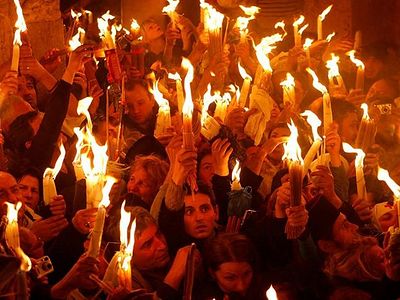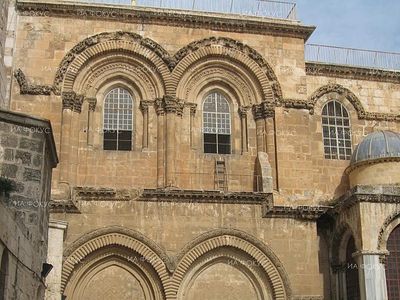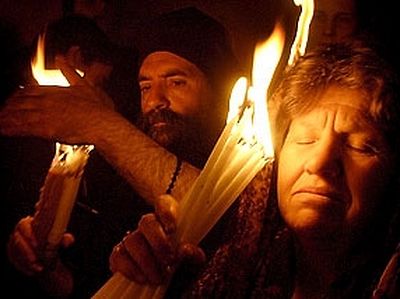This article was originally published in Russian on this site on Holy Saturday 2008, the day before Pascha [Easter].
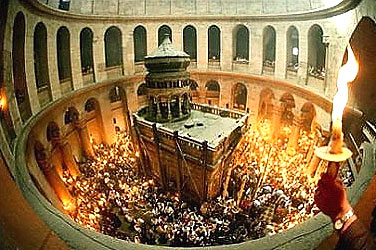 AP Photo / Oded Balilty
AP Photo / Oded Balilty
The fundamental idea of these “exposés” is that purportedly there are Orthodox who themselves deny the genuineness of this miracle but at the same time continue to “dupe simple, ingenuous people.” What arguments are offered to support this idea of duping and conscious deceit?
1. Professor N.D. Uspensky of the Leningrad Theological Academy (1900-1987).
Professor Uspensky did indeed consistently deny the genuineness of the descent of the Holy Fire, and dedicated to this denial a special report entitled “On the History of the Rite of the Holy Fire which is conducted on Holy Saturday in Jerusalem”, which he read aloud at a gathering in the assembly-hall at the Leningrad Theological Academy on 9 October 1949.
The fundamental position of Prof. Uspensky was not based on any irrefutable facts proving that deception from century to century has supposedly been carried out by all the Jerusalem patriarchs, but the idea that an annually repeating miracle at one and the same time is opposed to Christian teaching. He writes:
“It would be audacious to expect a fire from on high [to descend] on a particular day, hour and minute; it would be unworthy of the Christian calling to seek from year to year a sign at the Sepulchre of Christ, to Whose Divinity the Apostles and a multitude of martyrs attested with their blood; finally, it seems blasphemous to demand a supernatural fire [simply] for lighting our lampadas from Him Who for the greatest of sacraments, the Eucharist, made use of the natural fruits of the earth--bread and wine; however, among Eastern Christians—the Orthodox, Armenian-Gregorians, Jacobites and Copts—belief in the supernatural and miraculous origin of the ‘Holy Fire’ is extremely widespread.”
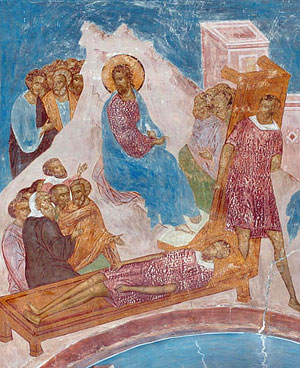 The healing of the paralytic. Diuonisios fresco. Photo: www.dionisy.com
The healing of the paralytic. Diuonisios fresco. Photo: www.dionisy.com
“Now there is at Jerusalem by the sheep market a pool, which is called in the Hebrew tongue ‘Bethesda’, having five porches. In these lay a great multitude of impotent folk, of blind, halt [lame], withered [paralyzed], waiting for the moving of the water. For an angel went down at a certain season into the pool, and troubled the water; whosoever then first after the troubling of the water stepped in, was made whole of whatsoever disease he had” (John 5:2-4).
As we see, depicted in this Gospel is a genuine, regularly-recurring miracle, occurring in one and the same place—just as in the case of the Holy Fire. Thus we are forced to recognize that what is “unworthy of the Christian calling” is not belief in a regularly-recurring miracle but the professor’s personal opinion that supposedly “Christian consciousness does not permit the miraculous appearance of fire on a particular day, hour and minute; for such a situation would reduce the Christian faith to the level of the so-called natural religions.”
The arguments offered by the professor against the Holy Fire simply do not stand up to critical reasoning. Thus for example, he points out the variety in the descriptions by pilgrims in various centuries of the manner of the descent of the Holy Fire--meanwhile, all the pilgrims attest to its being miraculous--and presents these variations in the descent as “contradictions”.
However, it is well-known that in different years, the manner or descent of the Holy Fire varies: it is well-documented that once it even descended outside the Church; likewise vary the miraculous manifestations that accompany the descent. Thus it is not surprising that the pilgrims described what they saw; and what they saw were different variations in the descent of the Holy Fire. Moreover, differences can also be attributed to the fact that each of the pilgrims used his (or her) own analogies and comparisons to describe what he or she saw. To affirm on the basis of these variations that no miracle took place at all is like affirming, on the basis of variations in the testimony of witnesses in a murder case, that no murder really took place.
Then Prof. Uspensky presents the ancient description of the church service in the Church of the Holy Sepulcher on Holy Saturday which is contained in the Holy Sepulcher’s Typicon for the year 1122. In it we read:
“The Patriarch then falls down before the holy altar and prays with tears for the sins of the people done in ignorance, raising his hands on high, doing this three times; those around him do the same thing. The people without ceasing call out, “Lord, have mercy.” Then the Patriarch and those around him enter the Holy Sepulcher, prostrate three times and pray and implore (God) for themselves and for the people. Then he lights [a candle] from the holy light and gives it to the archdeacon, and the archdeacon to the people. Then the Patriarch, archdeacon and the others with him exit [the Holy Sepulcher].[1]
It should be noted that “holy light” is a specific term used by the Greeks in antiquity (it is used in the 10th century by Nikita the Cleric as being in common use) and even now down to the present day to indicate that specific miracle which is referred to in Russian literature as the “Grace-filled fire” and in English literature as the “Holy Fire”.
But Prof. Uspensky opines that “the [merely] natural character of the rite of the Holy Fire in the ‘Typicon’ of the Holy Sepulcher is obvious,” and that “the term ‘holy light’ is to be understood as a kindled lampada.” One is forced to admit the obstinacy of the professor in trying to use in his own support even the evidence and testimonies which obviously contradict him. Why would the Holy Sepulcher Typicon’s author use the term “holy light” for an ordinary lampada? And why would the patriarch and all those with him fall down three times before an ordinary lampada? This argument of the professor could lead astray only atheists, because every church-going Orthodox person knows that lit lampadas (oil lamps) are not something unusual—there are many of them in every church, and the process for lighting them is the same as for the candles which are lit from them; the Orthodox do not give a distinctive sacral meaning to lampadas, do not call them “holy light” and do not fall down before them before lighting a candle from them (as described in the Holy Sepulcher Typicon).
The quotations cited by Professor Uspensky from the rite of the vespers service according to the Latal’sky and Kal’sky manuscripts also do not in any way support his assumptions.
His other arguments are so strained and insubstantial that they are closer to fantasies than something worthy of serious discussion, with the exception of one source he quotes (Bishop Porphyrius), whose frequency of citation is greater even than that of Prof. Uspensky; therefore we will now consider it separately:
2. Bishop Porphyrius Uspensky of Chigirinsky (1804-1886).
The words of Bishop Porphyrius, like the main trump card, are quoted by all critics of the Holy Fire, including Prof. Uspensky. Bishop Porphyrius, when still an archimandrite, visited Palestine; and in his diary-entries are two entries “unmasking” the miracle of the Holy Fire.
First, Bishop Porphyrius quotes a certain Hierodeacon Gregory, who “upon entering the chapel of the Sepulcher at the time when, according to common belief, the Holy Fire descends, saw with horror that the fire was being lit simply from a lampada which is always [kept] burning; and so the Holy Fire is not a miracle. He himself [Hierodeacon Gregory] told me about it today.”[2]
Second is the following story, which he says he heard directly from Metropolitan Dionysius:
In the same year that the famous Ibrahim, Pasha of Egypt and lord of Syria and Palestine, was in Jerusalem, it was found to be that the fire received at the Lord’s Sepulcher on Holy Saturday is a ‘not-holy fire’ [lit.: not grace-filled] but is kindled in the way that all flames are kindled. How? The Pasha wanted to see for himself if the fire really does suddenly and miraculously appear on the roof of the Sepulcher of Christ or if it is lit by an ordinary sulfur match. What did he do? He announced to the Patriarch’s representative hierarchs that it would be his pleasure to sit in the chapel itself during the receiving of the fire and watch vigilantly to see how it appears; and he added that if the miracle proved to be true, he would give [to the Church] 5000 poungs (2.5 million piasters); and if it turned out to be a lie, then they would [be forced to] give him all the money collected from the deceived worshippers, and he would print about the dirty fraud in all the newspapers of Europe. The Patriarchal representatives—Archbishop Misail of Petroaravisk, Metropolitan Daniel of Nazareth and Bishop Dionysius then of Philadelphia [in Asia Minor], now of Bethlehem—gathered to decide what to do. During the meeting, Misail admitted that in the inner-chapel he lights the fire from a lampada concealed behind the marble icon of the Resurrection of Christ located near the very Sepulcher. After this admission, it was decided to humble request Ibrahim not to meddle with religious affairs; and to the Pasha was sent the dragoman [interpreter] of the Holy Sepulcher Monastery, who informed the Pasha that there would be no benefit for His Radiance to get to know the sacraments and mysteries of Christian church-services and that the Russian Emperor Nicholas [I] would be greatly displeased if he started learning about these sacraments. Pasha Ibrahim heard the dragoman out, made a giving-up-the-idea gesture with his hand, and fell silent. But from that time on, the Holy-Sepulcher clerics no longer believe in the miraculous appearance of the fire. Having said all this, the metropolitan added that only from God can be expected the discontinuance of (our) pious lie. As He knows and is able, he soothes the people, who believe now in the miraculous fire of Holy Saturday. And for us is forbidden even to consider such a revolutionary act [of revealing the lie]; they would tear us pieces at the very chapel of the Holy Sepulcher.”[3]
Careful examination of this story raises a series of questions and considerations. First, neither Bishop Porphyrius himself nor the person he was talking to were witnesses of a fraud. Rather, Metropolitan Dionysius reportedly told a Russian Hieromonk [then-Archimandrite Porphyrius]; but Metr. Dionysius was also citing not something he himself witnessed but the witness of Archbishop Misail. Thus we have not a second-hand but a third-hand report. With Archbishop Misail himself, Bishop Porphyrius on this subject did not communicate.
However, another Russian pilgrim did talk directly with Archbishop Misail on that topic—Hieromonk Melety, who made a pilgrimage to the Holy Land in 1793-1794; and we see that Archbishop Misail himself spoke of the Holy Fire entirely differently, saying: “Entering the church and going to the Holy Sepulcher, we saw on the whole roof of the Sepulcher brilliant light, scattered around like small pearls, light blue, white, crimson, and other colors, which then streamed together, reddened, and became transformed in the course of time into fire; but this fire--for the period of time that it takes to say “Lord, have mercy” 40 times--does not burn; and from this fire are lit lampadas and candles.”[4]
Bishop Porphyrius and Hieromonk Melety both quote Archbishop Misail, but report directly opposite things. Whom should we believe? Logically, we should give more credit to the one who spoke directly with the archbishop than to the one who heard a story from a third person who reportedly quotes Archbishop Misail. Moreover, this third person—Metropolitan Dionysius—is likewise of greatly ambiguous character. Bishop Porphyrius himself mentions that, because of Metr. Dionysius’ instigation to massacre Catholics, the Jerusalem Patriarch “conceived the desire to remove him [from his post].”[5]
Moreover, the story told by Bishop Porphyrius gives rise in itself to doubts. For example, it is doubtful in the extreme that Pasha Ibrahim would suddenly so easily change his mind and walk away from the chance to get a huge sum of money from the Jerusalem Patriarch, having merely heard the name of the Russian Emperor. From history it is well known that in other cases, nothing stopped Ottoman officials from extracting needed sums of money from Christian brotherhoods and societies under their jurisdiction, including in Jerusalem. This story is seems more like a legend told to a Russian pilgrim in order to flatter his national pride.
But what should we make of that story of the hierodeacon in the 19th century who supposedly spied on the activities in the inner-chapel and was convinced that “there was no kind of miracle”? We have a similar story from a priest in the 20th century, Father Mitrophan, who decided to spy on the miracle--in which he doubted--; and his description is entirely different:
“I saw how the Blessed Patriarch took in his hands 33-candle bundles, raised them high above himself and began imploring God about sending down the Holy Fire. Again, very slowly, he started stretching out his arms toward heaven; he barely managed to raise them to the level of his head when suddenly, in the twinkling of an eye, the four bunches of candles in his hands and a lampada were kindled, as if they had been brought near to a fiery furnace.”[6]
On what basis could we believe the story of an unknown hierodeacon more than the just-mentioned report of a person whose integrity and holiness can be attested to by our still-living contemporaries who knew him personally?
Furthermore, Bishop Porphyrius also is far from being free of suspicion of unscrupulousness, judging from his desire to affirm by these and other stories “adjusted” to fit his own individual, personal hypotheses. He is known as a person who repudiated the story of the miraculous appearance of the Mother of God on Mount Athos (“The Mother of God was never on Athos and never even thought about it”), considering that Athonite monks dreamed up the story in order to deceive pilgrims and thus increase the income of their monastery. And this same Porphyrius, an archimandrite at the time, tried to convince Holy Hierarch [Saint] Philaret, Metropolitan of Moscow, that the Greek new-martyrs were “self-willed, self-called” martyrs, and that Athonite monks supposedly specially prepared them for martyrdom in order to then have their relics. Holy Hierarch Philaret was vigorously opposed to such a view, and in answer, “defended the Athonites and their martyrs, citing as examples ancient passion-bearers who offered themselves for martyrdom and whom the Church then enrolled in the choir of confessors.”[7] In conversations with Holy Hierarch Philaret, Father Porphyrius sometimes “permitted himself to use sharp expressions, from which he himself would then come to feel embarrassment. Father Porphyrius relates that in one of these cases, “Vladyka [Philaret] gave me a significant glance, and I bit my tongue…and changed the conversation to another topic.”[8]
As we see, Bishop Porphyrius was a person of highly personal ideas, prejudiced against miracles in general and much biased against Greek piety, whether expressed on Mount Athos or in Jerusalem. Taking into account his views, it is not at all surprising that he collected everywhere tales and fables which would validate his prejudices.
By all appearances, he himself was deceived by these stories. Anyone who has been at holy places knows that near them are a substantial number of doubtful characters who are ready to say any kind of rubbish in order to attract attention to themselves. Nevertheless, such a phenomenon as the spreading of false tales with great aplomb is found not only at holy places; one should think that many readers here have had the displeasure of observing this phenomenon and perhaps of suffering from it as well.
That the stories told by Bishop Porphyrius are mere gossip follows also from the fact that in more recent times the inner-chapel of the Lord’s Sepulcher was renovated, and no kind of hiding places behind “out-swinging icons” were found.
3. Archbishop Melety Smotritsky of Polotsk (1578-1633) and Patriarch Kirill Lucaris of Constantinople (1572-1638).
Archbishop Melety is remembered with sorrow as the person who turned from Orthodoxy to Catholicism and by means of various intrigues attempted (unsuccessfully) to draw after him his whole flock. In 1627, already having converted to the Unia[9], he wrote a letter to Patriarch Cyril Lucaris of Constantinople trying to incline him towards Catholicism; and in this letter, among other things, he wrote about the Holy Fire as not genuine, quoting the words of Cyril himself. “Y[our] Ho[liness] probably remembers that once I asked you why your representative hierarch, Archbishop Melety, when writing against the new Roman calendar…completely neglects to mention that great annual miracle in Jerusalem? To that question, Y[our] Ho[liness] answered me in the presence of two of your domestic high officials…that if this miracle really was taking place in our times, then all the Turks would long before already have believed in Jesus Christ. Even more sharply spoke of this the Patriarch of Jerusalem, the very one who gets the flame, brings it out and distributes it to the people. Thus, it is sorrowful to say that, regarding this miraculous flame which in the past really did appear but now because of our sins has ceased to appear, our Orthodox brothers prefer to be in accord with the heretics, such as the Eutychians, Dioscorites and Jacobites, rather than with the Catholics, who do not believe in this miracle for a very valid reason, especially in view of what the heretical Abyssynians do at the Lord’s Sepulcher during this time.[10]
One must say that the previously-mentioned Patriarch Cyril Lucaris of Constantinople is likewise sorrowfully well-known for renouncing Orthodoxy in the direction of Calvinism, which he expressed in his “Confession of Faith”, which is completely Calvinistic both in spirit and in letter. The “Confession” of Cyril Lucaris was condemned as a heresy by six Orthodox Councils in a row: the Council of Constantinople in 1638 (in which Cyril Lucaris himself was anathematized), the Council of Kiev in 1640, of Jassky in 1642, of Constantinople in 1672, of Jerusalem in 1672, and of Constantinople in 1691.[11]
If we examine the views and biographical particulars of both of these “Orthodox” hierarchs, we see that it is no surprise that they repudiated the miracle of the Holy Fire (which corroborates the truth of Orthodoxy), since one of them later converted to Catholicism, and the other de facto was a Protestant in his faith. Melety’s unspecific citing of the Jerusalem Patriarch in this connection likewise does not deserve credence, especially since he did not report what the Patriarch actually said. Moreover, considering how many times Melety converted to the Unia and then returned to Orthodoxy, accompanied by the solemn and public burning of his personal books and repudiation of his words, one is forced to recognize that the word of such a person carries very little weight, if any.
4. Gevond, a priest of the Armenian Church.
People skeptical of the Holy Fire also quote the words of a certain priest of the Armenian Church which were posted on one of the Armenian forums.
These words call forth astonishment in that it is atheists who quote them as evidence that there is nothing miraculous about the Holy Fire. This is surprising in that this priest affirms that the annual miracle at the Holy Sepulcher Church in Jerusalem started manifesting supposedly due to the prayers of Saint Gregory, the Enlightener of Armenia (4thC), and further on writes:
We in Jerusalem do not call [this miracle] the ‘Grace-filled Fire’ but ‘Light’—‘Luyis’, because for us, it is a prototype of Christ: ‘I am the Light,’ as the Lord said. Over the course of history, there have been occurrences when in a miraculous manner the candles lit themselves at the Lord’s Sepulcher….
And thus, this priest of the monophysite Armenian Church does not deny the miracle at all. He denies it only in regard to the role of the Orthodox Church, which supposedly “deceives its faithful into believing that the Fire descends from heaven.” According to him, this is what happens:
“At two o’clock in the afternoon, the doors are opened and the Greeks carry in there a covered (and lit) lampada and put in on the Sepulcher. After that, the Greeks begin a Procession of the Cross around the Sepulcher; for the third circle around [the Sepulcher], the Armenian archimandrite joins them, and together they move up to the doors. The first to go in is the Greek Patriarch and after him the Armenian. And both enter the Sepulcher, where both, kneeling, pray together. After this, first the Greek lights his candles from the lit lampada, and then the Armenian.”
The reasons why this priest Gevond decided to write about it are given by him in his introduction:
“This ‘Fire’ has become the personal property of the Orthodox. The “Fire” is brought forth as proof of Orthodoxy; that is, specifically at the prayer of the Orthodox [Patriarch], this ‘Fire’ descends from heaven. This ‘Fire’ proves that only the calendar of the Orthodox is true, since it is only on that day that the ‘Fire’ descends.”
Thus Gevond, not being Orthodox, explains his displeasure.
Only one thing in the preceding is not understandable: If the whole “trickery” of the Greeks is that they, in the sight of all, bring into the inner-chapel a lit lampada, from which later during the time of the service they light the candles and pass them around, then why do the Armenian clerics take part in this rite at all, and why have things gone so far on occasion that Armenian clerics have tried to take away from the Greek patriarch the candles which have been kindled from the Holy Fire? Was it simply that they didn’t have a match?
5. Certain Orthodox eye-witnesses who affirm that the Holy Fire scorches and burns like an ordinary flame.
One of these sources are the words, posted on an internet forum, of Hieromonk Flavian:
“Unfortunately, it burns. In 2004 my friend literally five minutes after receiving the Holy Fire (we had not even left the church) tried to “wash himself” in the fire. His rather slight beard began to flare up. I had to cry out to him to put it out. I had a video-camera in my hands, and so that sorrowful incident was recorded….I myself also tried following the example of others: I held my hand over the flame. It’s a fire like [any other] fire. It burns!”
This is quoted in the above form by the atheists. The four dots indicate that something is left out of the quote. Here is what is left out:
“We came to the conclusion that our faith is weak. However, it is strange that people by the thousands expect miracles from this annually occurring phenomenon. It is already a miracle in itself that the Fire descends from heaven. Thanks be to God for that!”
As we see, this eyewitness-- whose words are quoted by people who have never been to Jerusalem as supposedly disproving the genuineness of the miracle—does not at all deny the fact of the miraculous descent of the Fire; moreover, he provides an explanation for why he and his friend did not experience the miraculous qualities of the Fire. The explanation is very reasonable and does not refute or cast doubt on the first-hand accounts—many captured documentarily—of thousands of people who, on the contrary, did experience that the Holy Fire in its first minutes does not burn.
On that same internet forum, one can find, for example, such stories:
[A woman writes:] “I myself was a witness of this miracle. And the fact that it is a miracle I do not doubt in the least. Those bursts of light which light up the whole Church of the Lord’s Sepulcher are like the flashes from a photographic camera, only they are much more powerful, such as man has not yet created. And the flashes of lightning I saw for myself. And it’s true that the Fire does not burn. Is it not a miracle that for so many centuries, among such huge crowds (everyone stands crowded so tightly together that it’s difficult to raise your hand) there has never been a fire? You can’t imagine how much fire is around everywhere—and there has never been an accident. I lived in Jerusalem for a fairly long time; no one there has any doubt that it is a real miracle.”
[A man writes:] “My personal impressions of the Holy Fire, the descent of which I had the good fortune to observe three times:
1. Before the descent of the Fire, everywhere in the whole church, flashes of light descend. I saw them even in those places where the pilgrims had no cameras (the side-chapel of the Finding of the Cross of the Lord).
2. The fire descended, according to her faith, to Mother Maria, then laboring for the Lord in the Monastery of the Cross. Anyone who knows this selfless laborer, restoring more than one monastery in the Holy Land, could not suspect her of lying or collusion.
3. The Fire at first indeed does not burn and beards are not singed—I saw and experienced it personally.”
[Another man writes:] “First there, then here, many people’s candles began to burn right in their hands. The people hadn’t even lifted the candles over their heads. And then people began to pass this Holy Fire to each other….Overhead are bursts and flashes of this Holy Fire, and from it fly out in different directions burning sparks which light the Christians’ candles. This I saw with my own eyes….The Holy Fire has a special quality—in the first minutes it does not burn or singe. I took that bundle of [33] candles, touched it in the form of a cross to my forehead, mouth, and cheeks—there was no kind of burning or scorching. Then the fire begins to burn like a torch, the whole bundle [of candles] throws off sparks and light, but in the first minutes it does not burn.”
Those who wish may find still more testimonies of eye-witnesses of the miracle—our contemporaries.
But of course it is not surprising that under certain circumstances the Holy Fire may burn someone. This does not in any way detract from its miraculous character. Thus, for example, the fire which by the word of the prophet Elijah came down upon the dishonorable soldiers who were sent to take him, was both miraculous in its origin and greatly burning in its action.
6. Deacon Andrei Kuraev, quoting Patriarch Theophilus III of Jerusalem.
Father Andrei Kuraev, after his return from Jerusalem where he was present at the meeting [2008] between Patriarch Theophilus and journalists from Russia, gave out [in Russian, except for the word “representation”] the following statement: “No less candid was his [the Patriarch’s] answer about the Holy Fire: ‘This ceremony is a “representation”, like all of the other ceremonies of Holy Week. Just as long ago the Paschal news from the Sepulcher shone forth and enlightened the whole world, so now we also in this ceremony carry out a representation of how the news of the Resurrection from the Sepulcher spread throughout the whole world.’ In the Patriarch’s speech was neither the word ‘miracle’ nor the word ‘descent’. About a cigarette-lighter in his pocket he probably could not have spoken in a more candid way.”
This interpretation of the Patriarch’s words is open violence on the actual content of the text. The Patriarch in no way denied the miraculous descent of the Fire but was speaking here only of its significance.
What is hidden in the word ‘representation”, which Father Andrei left as is, without translation? Mueller’s English-Russian Dictionary gives the following meanings [translated from the Russian]: “1) idea, notion, conception; presentation, portrayal, picture; 2) image, depiction, symbol; 3) (often pl) assertion, statement, affirmation; declaration; 4) a presentation or production, as of putting on a play; 5) the condition of serving as an official delegate, agent or spokesman; 6) protest.”
It is clear that Father Andrei understood the word “representation” in its fourth meaning, “a presentation or production, as of a play”; but this interpretation does not fit, because then we get the translation: “This ceremony, which is a production or putting on of a play, like all the other ceremonies of Holy Week,” which implies that supposedly the Jerusalem Patriarch considers the church-services in general of the Orthodox Church to be “play-productions”.
In actual fact, it is clear that the Patriarch used the word “representation” in its more common meaning; and in this case there is nothing “subversive” in his words; his meaning was simply: “This ceremony, which is a depiction, a portrayal, like all the other ceremonies of Holy Week….We in this ceremony give an image, a depiction of how the news of the Resurrection spread from the Sepulcher-chapel throughout the whole world.” The word “ceremony”, which was also not translated but simply transcribed [letter by letter] by Father Andrei, has the basic meaning of “rite”; and among less common meanings, “etiquette” and “formality” (according to Mueller). If we want to take a stab at the Jerusalem Patriarch, why not here also play with meanings in a translation of this spirit: “No less candid was his answer about the Holy Fire: ‘This formality, which is a play-production, like all the other formalities of Holy Week…”?
Finally, that the words and interpretations of Deacon Andrei Kuraev do not correspond to reality, was reported with sorrow by Vladimir Yakunin, head of the Trustee Council of the Apostle Andrew Foundation and organizer of this very trip of the journalists to the Holy Land: “To tell the truth, I am distressed by the interpretations which are given on the Kuraev site….In the recordings of what the Patriarch said, given in the English language, we hear how he consistently uses the term “Holy Fire”. In my view, there is no basis at all for interpreting the Patriarch’s words as if he were in essence denying the holiness of the “Holy Fire”. [italics added]
By the way, if we wish to take a look at what other Jerusalem Patriarchs have said about the Holy Fire, then why not recall the words of the previous Patriarch, Irinaeus I: “Those who do not believe in the Holy Fire are worms and rubbish!”
Three problems for skeptics
It is not surprising that atheists, heretics and schismatics contrive to deny the genuineness of the Holy Fire. But it is surprising that sometimes they are joined by Orthodox who seem to think that it’s no big deal to deny the genuineness of this miracle. As if a true believer could be indifferent: either the Lord is really sending a sign, or for over a thousand years the Jerusalem Patriarchs and hierarchs, among whom are not a small number who have been glorified in the choir of the saints, have been cynically deceiving the Orthodox of the whole world, moreover on the eve of the Feast of Feasts.
Any person with a sense of honor notices the difference between these two choices.
A person educated in Orthodoxy also knows that this difference was emphasized unequivocally in the resolutions of the Local Council of Constantinople in 1084:
“To those who, rather than with pure faith, in simplicity of heart, and from their whole soul, accept as undoubted realities, the great miracles done by our Saviour and God, by our Holy Lady the Mother of God who without defilement gave Him birth, and by the other saints, instead make efforts by means of worldly wisdom to present these miracles as impossible or misinterpret them according to their own ideas, and stubbornly persist in their opinion—anathema.”
Personally I cannot consider convincing the objections of the critics of the Holy Fire for a whole series of reasons. For example, I don’t understand how all their hypotheses— by the way, often contradicting each other—could explain the fact, for example, that in the ninth century the Moslem ruler of Jerusalem ordered that metal (copper) wicks be placed in all the lampadas; and despite this, in the sight of everyone, the fire descended and the metal wicks caught fire and began to burn. This is attested to by both Greek historians (Nikita the Cleric) and by Arab historians (Biruni). And of what use are “lighter in the pocket” explanations when candles outside the Sepulcher chapel are ignited before the very eyes of the pilgrims, or when the fire comes down from icons, etc.
But in particular three problems for skeptics arise to which I have so far not been able find a clear solution in any of the “skeptical” articles:
1. The bursts of light.
Frequently (although not every year) pilgrims observe, before the descent of the Holy Fire, bursts or flashes of pale blue light in the church, similar to those which occur during flashes of lightning. They are documented on video-film (see: http://www.holyfire.org/image/blist.mpg).
Skeptics confidently affirm that these bursts of light are nothing but camera-flashes. There is indeed a certain similarity, but photo-flashes are much, much weaker and don’t have that particular hue [shade of color].
And another snag arises for the skeptic: how to deal with the fact that ancient eye-witnesses of the miracle described the same phenomenon of supernatural light.
Take, for example, Nikita the Cleric who, visiting Jerusalem in the year 947, wrote: “The Archbishop had still not come out of the Sepulcher when one could suddenly see the whole Church of God filled with an irresistible and Divine light, so that the pious people moved now to the right side, now to the left….In the presence of such an unexpected manifestation of light, all were filled with amazement, so that even the godless Hagarenes were thunderstruck and put to shame…Now, during the present time, the Divine outpouring of light has expanded and filled the whole church.”[12]
Igumen [Abbot] Daniel, visiting the holy places in 1106-1107, testifies: “Then suddenly a holy light began to shine in the Sepulcher, and bright sparkles emanated from the Sepulcher.”[13]
The pilgrim Triphon Korobeinikov, who was in Jerusalem in 1583, affirms that in the church “fire comes…like lightning from heaven.”[14]
It is to be recalled that in the 10th, 12th, and 16th centuries, photo-flashes did not exist.
2. Documentary proof that the Holy Fire does not burn.
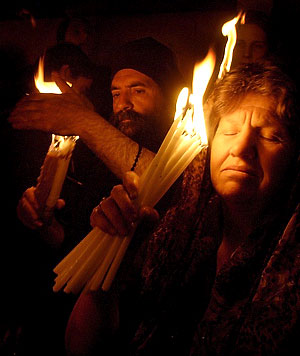 Photo: Micah Walter
Photo: Micah Walter
In any case, we know that with an ordinary flame, especially over it, it is very difficult to hold one’s hand for even one second. Anyone who doubts this can check it out right now, holding his or her hand over a lit match or burning candle, or over a lighter or any ordinary flame. So check it out. Can you do it for five seconds, or at least three? Be sure to have handy some anti-burn ointment and a big band-aid!
It is worthy of note that the young atheist (mentioned at the beginning of this article) who a year ago [2007] made available on the Internet his “exposé” of the Holy Fire, besides other things, showed a video where he passes his hand over ordinary lit candles. And although it seemed to him that this was the same as the pilgrims did, it’s quite noticeable that during the four-second clip, he pulled his hand out of the flame four times, which is not true of the video-clips of the pilgrims.
Thus, we can say that either the Holy Fire did not burn these pilgrims shown on the video-clips, or else the Lord every year on Holy Saturday grants ordinary people great self-control and strength of will when burned by fire in the Church of the Holy Sepulcher. Or we might say: before us is either a miraculous flame, or miraculous people who don’t feel pain from ordinary fire.
3. Other yearly Orthodox miracles.
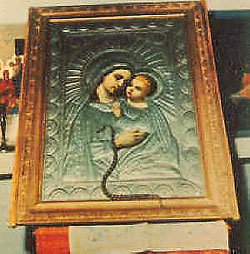 Snakes in Keffalonia
Snakes in Keffalonia
Let us take for our example the miracle with the snakes on the Greek island of Cephalonia in the village Markopulo. Earlier here was a women’s monastery which was attacked by pirates. The nuns prayed for rescue in front of the “Longobard” icon of the Mother of God. And a miracle occurred: When the pirates broke down the monastery gates, instead of nuns they saw snakes and fled in terror. Now every year, precisely on the Feast of the Dormition [Assumption] of the Mother of God, during the liturgy, snakes from all over the island crawl into the church located on the monastery grounds. For the duration of the whole service, they are among the people. People touch the snakes, pick them up, even drape them around their necks; but the snakes do not harm anyone. After the service, they crawl out of the church and do not return until the following year. All this has been caught on video. And anyone who wishes to see for themselves can go to Cephalonia on 15 August.
Known also are other regularly occurring miracles granted by the Lord for strengthening Orthodox Christians, but here it is enough to mention Cephalonia; if Orthodox and non-Orthodox skeptics deny the miracle of the Holy Fire, then what will they say about this miracle? What kind of cigarette lighter allures these snakes to come into the church? If in the case of the Holy Fire, speculation centers around the fact that the miracle happens in the tiny chapel to which only the Patriarch has access, here in Cephalonia the miracle occurs before the eyes of all the parishioners.
Apparently, religious skeptics, heretics and schismatics are especially against the Holy Fire because its existence especially scorches their souls.
***
In a short article, it is not possible to mention all the evidence and testimony about the Holy Fire and all the history and stories connected with it; therefore, whoever is interested is recommended to visit the site “Holy Fire. Holy Fire in Jerusalem is yearly miracle in Church of Holy Sepulchre”, where they also critically investigate other attempts [than those mentioned here] to call into question the genuineness of this miracle of God.
In conclusion, it would not be superfluous to quote one more direct witness of the miracle, our contemporary, Bishop Gabriel of Blagoveshensk in the Far East of Russia.
“Did you see how the Paschal Fire descends?”
“Yes, I saw it two times. Archbishop Anthony Zavgorodny was still alive then. And when on Holy Saturday the Patriarch came out with the Holy Fire, Vladyka Anthony and I did not try to light our candles from it, but quickly scurried into the chapel of the Lord’s Sepulcher; one Greek ran in, plus Vladyka and I. And we saw in the Sepulcher of the Lord a flame of a [dark] blue, heavenly color; we took it in our hands and washed ourselves with it. For a certain number of seconds it didn’t burn, but then it acquired its usual powers and we lit our candles.”
“The Fire was burning directly on that large, flat stone covering the Tomb?”
“Yes, on that stone. And all the lampadas were burning. And the whole stone was covered with fire….You have to see it! I also, if I hadn’t seen it, would have my doubts. But I saw it myself: The Fire is ablaze and we are washing ourselves. Everywhere is only rock and marble—and everything is covered with fire. No soot, no nothing….The fire is simply burning— that’s all.”[15]



